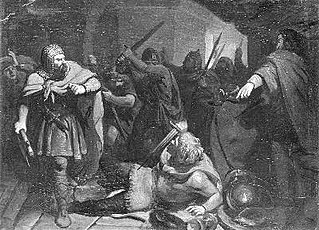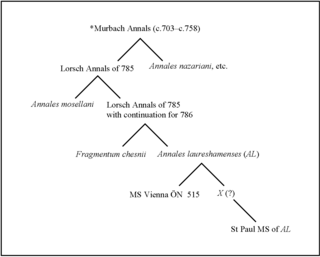Related Research Articles
Annals are a concise form of historical writing which record events chronologically, year by year. The equivalent word in Latin and French is annales, which is used untranslated in English in various contexts.
Thiota was a heretical Christian prophetess of the ninth century. She was originally from Alemannia, and in 847 she began prophesying that the world would end that year.

The Royal Frankish Annals, also called the Annales Laurissenses maiores, are a series of annals composed in Latin in the Carolingian Francia, recording year-by-year the state of the monarchy from 741 to 829. Their authorship is unknown, though Wilhelm von Giesebrecht suggested that Arno of Salzburg was the author of an early section surviving in the copy at Lorsch Abbey. The Annals are believed to have been composed in successive sections by different authors, and then compiled.

Godfrid, Godafrid, Gudfrid, or Gottfrid was a Danish Viking leader of the late ninth century. He had probably been with the Great Heathen Army, descended on the continent, and became a vassal of the emperor Charles the Fat, controlling most of Frisia between 882 and 885.
The Battle of Leuven, also called the Battle of the River Dyle, was fought in September 891 between East Francia and the Vikings. The existence of this battle is known through several different chronicles, including the Annales Fuldenses and the Anglo-Saxon Chronicle. The Battle of the Dyle occurred near the present-day location of the city of Leuven in Belgium. In the 880s the Vikings established a camp there that they used as a base of operations from which to launch raids into the fractured Frankish kingdom. Efforts to verify the report of the battle from the Annales Fuldenses, specifically the huge loss of life on the Viking side, have been hindered by the lack of archaeological excavations in Belgium.

Fulk the Venerable was archbishop of Reims from 883 until his death. He was a key figure in the political conflicts of the West Frankish kingdom that followed the dissolution of the Carolingian Empire in the late ninth century.

The Abbey of St Vaast was a Benedictine monastery situated in Arras, département of Pas-de-Calais, France.

The Annales Fuldenses or Annals of Fulda are East Frankish chronicles that cover independently the period from the last years of Louis the Pious to shortly after the end of effective Carolingian rule in East Francia with the accession of the child-king, Louis III, in 900. Throughout this period they are a near contemporary record of the events they describe and a primary source for Carolingian historiography. They are usually read as a counterpart to the narrative found in the West Frankish Annales Bertiniani.
Annales Bertiniani are late Carolingian, Frankish annals that were found in the Abbey of Saint Bertin, Saint-Omer, France, after which they are named. Their account is taken to cover the period 830-82, thus continuing the Royal Frankish Annals (741–829), from which, however, it has circulated independently in only one manuscript. They are available in the Monumenta Germaniæ Historica and in a later French edition taking into account a newly discovered manuscript . The Annals of St. Bertin are one of the principal sources of ninth-century Francia, and are particularly well-informed on events in the West Frankish sphere of Charles the Bald. The Annales Fuldenses are usually read as an East Frankish counterpart to their narrative.
Henry was the leading military commander of the last years of the Carolingian Empire. He was commander-in-chief under Kings Louis the Younger and Charles the Fat. His early career was mostly restricted to East Francia, his homeland, but after Charles inherited West Francia in 884 he was increasingly active there. During his time, raids by the Vikings peaked in Francia. The sources describe at least eight separate campaigns waged by Henry against the Vikings, most of them successful.
The Reichsannalen are a class of annals composed anonymously in the Carolingian Empire throughout the 9th century. They first appeared under Pepin the Short in 741 and became ubiquitous at monasteries throughout the empire in the following decades. They were not official court annals, but they often bear the bias of having been written in one regnum or another.

The Annales Xantenses or Annals of Xanten are a series of annals which adapt and continue the Royal Frankish Annals. Their first editor, Georg Pertz, thought they were perhaps written at the monastery at Xanten, hence their name. However, according to Heinz Löwe, the entries from 790 to around 860 were probably written at Lorsch by Gerward, a royal chaplain. Löwe suggests that the manuscript subsequently passed to Cologne, and around 871 new entries were written there, for the years from 861 onwards. This part of the text is hostile to Archbishop Gunthar of Cologne.
Sunderolt was the Archbishop of Mainz from 889 until his death.
The siege of Asselt was a Frankish siege of the Viking camp at Ascloha (Asselt) in the Meuse valley in the year 882. Though the Vikings were not forced by arms to abandon their camp, they were compelled to come to terms whereby their leader, Godfrid, was converted to Christianity.
SolomonII was the Bishop of Constance from 875 until his death. He was a relative of his predecessor and namesake Solomon I and stood in the middle of an "episcopal dynasty." He was commended for his life when the Annales Fuldenses record his death. He was succeeded by his own namesake and another relative, Solomon III.

The Annales laureshamenses, also called Annals of Lorsch (AL), are a set of Reichsannalen that cover the years from 703 to 803, with a brief prologue. The annals begin where the "Chronica minora" of the Anglo-Saxon historian Bede leaves off—in the fifth year of the Emperor Tiberios III—and may have originally been composed as a continuation of Bede. The annals for the years up to 785 were written at the Abbey of Lorsch, but are dependent on earlier sources. Those for the years from 785 onward form an independent source and provide especially important coverage of the imperial coronation of Charlemagne in 800. The Annales laureshamenses have been translated into English.

The Fragmentum (annalium) chesnii or chesnianum, sometimes called the Annales Laureshamenses antiquiores, is a brief set of Reichsannalen describing the history of Francia during the years 768 to 790. It is named after André Duchesne, who first edited and published it in his book Historiae Francorum scriptores (1:21–23) in 1636. It has been re-edited by Georg Heinrich Pertz for the Monumenta Germaniae Historica, Scriptores I, 30–34.

The Annales mosellani or mosellenses (AM) or Moselle Annals are a set of minor Reichsannalen covering the years 703 to 798. Its entries are brief and unliterary, but broad in scope and generally accurate. They have only partially been translated into English.
The Annales guelferbytani are a set of Latin annals covering the years 741–805 that were composed in Regensburg, the capital of the Duchy of Bavaria, in 812–13. They are found in a manuscript of the ducal library of Wolfenbüttel, which contains fourteen folios, though folio 13r was added later and folios 13v–14v later still.
Engeldeo or Engildeo was the Margrave of Bavaria from 890 to 895.
References
- Reuter, Timothy (trans.) The Annals of Fulda . (Manchester Medieval series, Ninth-Century Histories, Volume II.) Manchester: Manchester University Press, 1992.
- Annales Vedastini